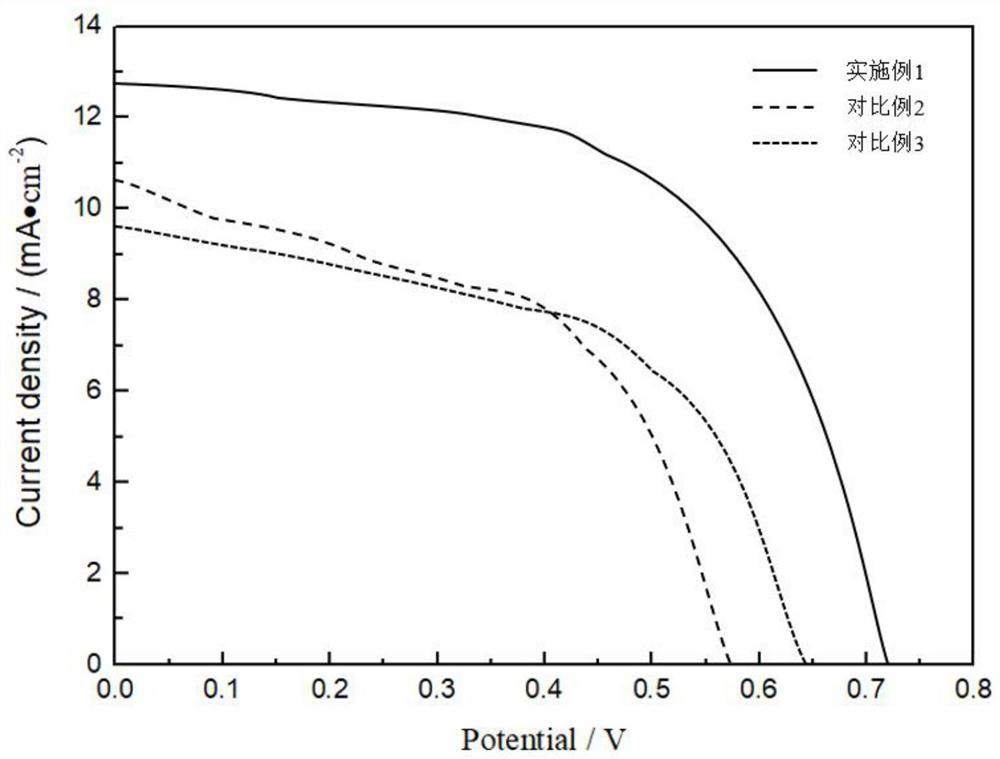Photo-anode based on flexible substrate and production method thereof
A flexible substrate and photoanode technology, applied in the field of solar cells, can solve the problems of poor bending ability and low photovoltaic conversion efficiency of flexible solar cells, and achieve the effect of good flexibility and tensile properties
- Summary
- Abstract
- Description
- Claims
- Application Information
AI Technical Summary
Problems solved by technology
Method used
Image
Examples
Embodiment 1
[0028] Step 1: Add polyacrylonitrile to dimethylformamide and sonicate for 8 minutes, then stir in a water bath at 45°C for 16 hours to obtain a precursor solution with a concentration of 0.1 g / ml; then transfer the precursor solution to a syringe for electrostatic Spinning: After spinning, put the obtained fiber film into a vacuum oven at 75°C for 30 hours to dry; after drying, pre-oxidize at 270°C for 1 hour, and then carbonize the product at 1000°C for 2 hours under a nitrogen atmosphere to obtain carbon fibers.
[0029] Step 2: Soak the carbon fiber prepared in step 1 in 10wt% NaOH solution for 6 minutes, take out the carbon fiber and immerse it in 1mol / L hydrochloric acid at room temperature for 12 minutes, then immerse the carbon fiber in absolute ethanol for 5 minutes and ultrasonically Repeatedly wash 6 times with deionized water; then soak the carbon fiber in 150ml of deionized water, and add FeSO 4 ·7H 2 O and carbon fiber mass of 0.13 phosphoric acid, after stirrin...
Embodiment 2
[0034] Step 1: Add polyacrylonitrile to dimethylformamide and sonicate for 9 minutes, then stir in a water bath at 50°C for 12 hours to obtain a precursor solution with a concentration of 0.12 g / ml; then transfer the precursor solution to a syringe for electrostatic Spinning: After spinning, put the obtained fiber film in a vacuum oven at 80°C for 24 hours to dry; after drying, pre-oxidize at 280°C for 1 hour, and then carbonize the product at 1000°C for 2 hours under a nitrogen atmosphere to obtain carbon fibers.
[0035] Step 2: Soak the carbon fiber prepared in step 1 in 10wt% NaOH solution for 5 minutes, take out the carbon fiber and immerse it in 1mol / L hydrochloric acid for 11 minutes at room temperature, then immerse the carbon fiber in absolute ethanol for 5 minutes and ultrasonically Repeatedly wash 6 times with deionized water; then soak the carbon fiber in 150ml of deionized water, and add FeSO 4 ·7H 2 O and carbon fiber mass of 0.18 phosphoric acid, after stirring...
Embodiment 3
[0040] Step 1: Add polyacrylonitrile to dimethylformamide and sonicate for 10 minutes, then stir in a water bath at 48°C for 13 hours to obtain a precursor solution with a concentration of 0.11 g / ml; then transfer the precursor solution to a syringe for electrostatic Spinning: After spinning, put the obtained fiber film in a vacuum oven at 78°C for 27 hours to dry; after drying, pre-oxidize at 275°C for 2 hours, and then carbonize the product at 1000°C for 2 hours under a nitrogen atmosphere to obtain carbon fibers.
[0041] Step 2: Soak the carbon fiber prepared in step 1 in 10wt% NaOH solution for 6 minutes, take out the carbon fiber and immerse it in 1mol / L hydrochloric acid at room temperature for 10 minutes, then immerse the carbon fiber in absolute ethanol for 4 minutes and ultrasonically Repeatedly wash 6 times with deionized water; then soak the carbon fiber in 150ml of deionized water, and add FeSO 4 ·7H 2 O and carbon fiber mass of 0.15 phosphoric acid, after stirri...
PUM
 Login to View More
Login to View More Abstract
Description
Claims
Application Information
 Login to View More
Login to View More - R&D
- Intellectual Property
- Life Sciences
- Materials
- Tech Scout
- Unparalleled Data Quality
- Higher Quality Content
- 60% Fewer Hallucinations
Browse by: Latest US Patents, China's latest patents, Technical Efficacy Thesaurus, Application Domain, Technology Topic, Popular Technical Reports.
© 2025 PatSnap. All rights reserved.Legal|Privacy policy|Modern Slavery Act Transparency Statement|Sitemap|About US| Contact US: help@patsnap.com


